Application of Intelligent and Digital Technologies to the Tasks of Wind Energy
Abstract
:1. Introduction
1.1. Wind Energy Conversion Systems and Their Control
- Tracking the maximum power generation point according to the WEC system schedule.
- Controlling a wind turbine blade angle.
- Predicting the generated power by wind farms and wind speed on the territory of a wind farm.
1.2. Atmospheric Boundary Layer in the Vicinity of a Wind Farm
2. Materials and Methods
2.1. Modeling of the Atmospheric Boundary Layer in the Vicinity of a Wind Farm
2.2. Cluster Analysis of the ABL in the Vicinity of a Wind Farm
2.3. Intelligent Systems in the Tasks of Wind Energy
- Optimization of the output power of the wind turbine. At wind speed from cut-in speed to cut-out speed, the pitch angle must maintain a constant optimal value so that the turbine produces the maximum possible power.
- Limitation of the turbine output power. With winds speed above cut-out speed, the angle changes according to a certain law, thereby, regulating the aerodynamic power and rotor load.
- (1)
- If () and () negative are very large, then the output power is greater than the nominal value, and the amplitude of the power change increases; therefore, it is necessary to reduce the pitch angle.
- (2)
- If () negative is very large and () positive is very large, then the output power is higher than the nominal; however, the amplitude of its change is reduced, and thus the change in the pitch angle will be minor [20].
2.4. CFD Methods for the Wind Turbine Modeling
3. Results
3.1. Results of the Cluster Analysis of the Atmospheric Boundary Layer in the Vicinity of a Wind Farm
3.2. Results of Wind Turbine Fuzzy Modeling
3.3. Results of Wind Turbine CFD-Modeling
4. Conclusions
Author Contributions
Funding
Data Availability Statement
Conflicts of Interest
Abbreviations
| WEC | wind energy conversion |
| ABL | atmospheric boundary layer |
| CFD | computational fluid dynamics |
| MPPT | maximum power point tracking |
| THD | total harmonic distortions |
| PI | proportional–integral |
| MMPT | maximum power point tracking |
| THD | total harmonic distorsions |
| FLC | fuzzy logic conversion |
| RANS | Reynolds-averaged Navier–Stokes |
| LES | large eddy simulation |
| DNS | direct numerical simulation |
References
- Borisov, V.; Kruglov, V.V.; Fedulov, A.S. Fuzzy Models and Networks, 2nd ed.; Hotline-Telecom: Moscow, Russia, 2012; 284p. (In Russian) [Google Scholar]
- Vermeer, L.J.; Sørensen, J.N.; Crespo, A. Wind turbine wake aerodynamics. Prog. Aerosp. Sci. 2003, 39, 467–510. [Google Scholar] [CrossRef]
- Altas, I.H. Fuzzy Logic Control in Energy Systems with Design Applications in MATLAB/Simulink; The Institution of Engineering and Technology: London, UK, 2017; 520p. [Google Scholar]
- Sumathi, S.; Kumar, L.A.; Surekha, P. Solar PV and Wind Energy Conversion Systems; Springer International Publishing: Cham, Switzerland, 2015; 807p. [Google Scholar]
- Shu, Y.; Yuan, Q.; Ke, W.; Kou, L. Security Access Control Method for Wind-Power-Monitoring System Based on Agile Authentication Mechanism. Electronics 2022, 11, 3938. [Google Scholar] [CrossRef]
- Kou, L.; Li, Y.; Zhang, F.; Gong, X.; Hu, Y.; Yuan, Q.; Ke, W. Review on Monitoring, Operation and Maintenance of Smart Offshore Wind Farms. Sensors 2022, 22, 2822. [Google Scholar] [CrossRef] [PubMed]
- Balouch, S.; Abrar, M.; Abdul Muqeet, H.; Shahzad, M.; Jamil, H.; Hamdi, M.; Malik, A.S.; Hamam, H. Optimal Scheduling of Demand Side Load Management of Smart Grid Considering Energy Efficiency. Front. Energy Res. 2022, 10, 861571. [Google Scholar] [CrossRef]
- Iqbal, M.M.; Sajjad, I.A.; Nadeem Khan, M.F.; Liaqat, R.; Shah, M.A.; Muqeet, H.A. Energy Management in Smart Homes with PV Generation, Energy Storage and Home to Grid Energy Exchange. In Proceedings of the International Conference on Electrical, Communication, and Computer Engineering (ICECCE), Swat, Pakistan, 24–25 July 2019; pp. 1–7. [Google Scholar]
- Zhang, J.; Xu, S. Application of Fuzzy Logic Control for Grid-Connected Wind Energy Conversion System. In Fuzzy Logic—Tool for Getting Accurate Solutions; IntechOpen: London, UK, 2015; Available online: https://www.intechopen.com/chapters/48179 (accessed on 31 October 2022).
- Berboucha, A.; Djermouni, K.; Ghedamsi, K.; Aouzellag, D. Fuzzy Logic Control of Wind Turbine Storage System Connected to the Grid Using Multilevel Inverter. Int. J. Energ. 2017, 2, 15–23. [Google Scholar] [CrossRef]
- Adzic, E.; Ivanovic, Z.; Adzic, M.; Katic, V. Maximum Power Search in Wind Turbine Based on Fuzzy Logic Control. Acta Polytech. Hung. 2009, 6, 131–149. [Google Scholar]
- Aissaoui, A.G.; Tahour, A.; Abid, M.; Essounbouli, N.; Nollet, F. Power control of wind turbine based on fuzzy controllers. Energy Procedia 2013, 42, 163–172. [Google Scholar] [CrossRef] [Green Version]
- Honarbari, A.; Najafi-Shad, S.; Saffari Pour, M.; Ajarostaghi, S.S.M.; Hassannia, A. MPPT Improvement for PMSG-Based Wind Turbines Using Extended Kalman Filter and Fuzzy Control System. Energies 2021, 14, 7503. [Google Scholar] [CrossRef]
- Pal, E.; Tiwari, Y.; Mishra, A. Variable Speed Wind Power Generation System Based on Fuzzy Logic Control for Maximum Output Power Tracking. Int. J. Eng. Res. Technol. 2014, 3, 1132–1135. [Google Scholar]
- Balaji, G.; Gnanambal, I.; Gajendran, P. Fuzzy logic controller based wind energy conversion system. Int. J. Electr. Electron. Eng. Res. 2013, 3, 287–296. [Google Scholar]
- Zubova, N.V. Fuzzy control of wind turbines with variable blade geometry. In New Non-Traditional and Renewable Sources of Energy; Institute of Thermal Physics SB RAS: Novosibirsk, Russia, 2013; pp. 49–50. (In Russian) [Google Scholar]
- Kumar Pradeep, C.A.; Benuel Sathish Raj, A. Comparative Study between Wind and Fuel Cell by Using Fuzzy Logic Control. Int. J. Eng. Adv. Technol. 2014, 3, 292–298. [Google Scholar]
- Mengi, O.O.; Altas, I.H. Fuzzy logic control for a wind/battery renewable energy production system. Turk. J. Electr. Eng. Comput. Sci. 2012, 20, 187–206. [Google Scholar] [CrossRef]
- Altas, I.H.; Mengi, O.O. A Fuzzy Logic voltage Controller for off-grid wind turbine/supercapacitor renewable energy source. In Proceedings of the eighth International Conference on Electrical and Electronics Engineering (ELECO), Bursa, Turkey, 28–30 November 2013; pp. 62–66. [Google Scholar]
- Zhang, J.; Cheng, M.; Chen, Z.; Fu, X. Pitch angle control for variable speed wind turbines. In Proceedings of the Third International Conference on Electric Utility Deregulation and Restructuring and Power Technologies, Nanjing, China, 6–9 April 2008; pp. 2691–2696. [Google Scholar] [CrossRef]
- Farh, H.M.; Eltamaly, A.M. Fuzzy logic control of wind energy conversion system. J. Renew. Sustain. Energy 2013, 5, 023125. [Google Scholar] [CrossRef]
- Parayil, A.P.; Ismail, A. Fuzzy logic pitch control of variable speed wind turbine. Int. Res. J. Eng. Technol. 2017, 4, 1200–1207. [Google Scholar]
- GOST R 54084-2010; Models of the Atmosphere in the Boundary Layer at Altitudes from 0 to 3000 m for Aerospace Practice. Parameters; Standartinform: Moscow, Russia, 2013; 126p. (In Russian)
- Porté-Agel, F.; Wu, Y.-T.; Lu, H.; Conzemius, R.J. Large-eddy simulation of atmospheric boundary layer flow through wind turbines and wind farms. J. Wind. Eng. Ind. Aerodyn. 2011, 99, 154–168. [Google Scholar] [CrossRef]
- Mehta, D.; van Zuijlen, A.H.; Koren, B.; Holierhoek, J.G.; Bijl, H. Large Eddy Simulation of wind farm aerodynamics: A review. J. Wind. Eng. Ind. Aerodyn. 2014, 133, 1–17. [Google Scholar] [CrossRef]
- Churchfield, M.J.; Lee, S.; Michalakes, J.; Patrick, P.J. A numerical study of the effects of atmospheric and wake turbulence on wind turbine dynamics. J. Turbul. 2012, 13, N14. [Google Scholar] [CrossRef]
- Alinot, C.; Masson, C. Aerodynamic Simulations of Wind Turbines Operating in Atmospheric Boundary Layer with Various Thermal Stratifications. In Proceedings of the ASME 2002 Wind Energy Symposium, Reno, NV, USA, 14–17 January 2002; pp. 206–215. [Google Scholar] [CrossRef]
- Baidya Roy, S.; Pacala, S.W.; Walko, R.L. Can large wind farms affect local meteorology? J. Geophys. Res. 2004, 109, D19101. [Google Scholar] [CrossRef]
- Kovalnogov, N.N. Applied Mechanics of Liquid and Gas; Ulstu: Ulyanovsk, Russia, 2010; 209p. (In Russian) [Google Scholar]
- Kovalnogov, V.N.; Fedorov, R.V.; Chukalin, A.V.; Tsvetova, E.V.; Kornilova, M.I. Modeling and Investigation of the Effect of a Wind Turbine on the Atmospheric Boundary Layer. Energies 2022, 15, 8196. [Google Scholar] [CrossRef]
- Arthur, D.; Vassilvitskii, S. k-Means++: The Advantages of Careful Seeding; Stanford University: Stanford, CA, USA, 2006. [Google Scholar]
- Pashchenko, F.F.; Torshin, V.V. On the influence of the angle of inclination of the blade surface on the dynamic characteristics of wind turbines. Probl. Mashinostroeniya I Avtom. 2012, 3, 41–46. (In Russian) [Google Scholar]
- Star CMM+ Singapore. Available online: https://star-ccm.com (accessed on 20 October 2022).
- Dufresne, N.P.; Wosnik, M. Velocity deficit and swirl in the turbulent wake of a wind turbine. Mar. Technol. Soc. J. 2013, 47, 193–205. [Google Scholar] [CrossRef]



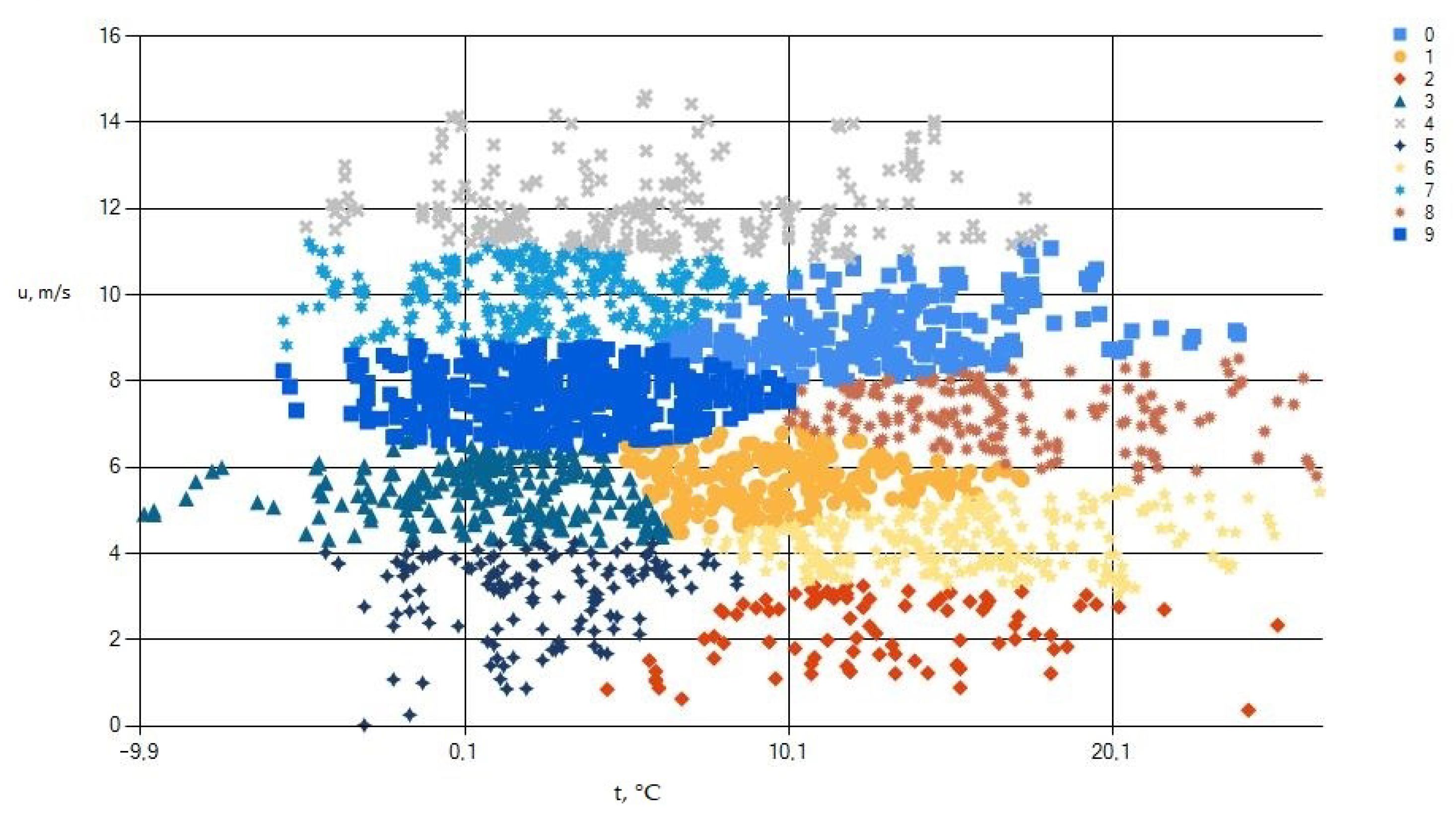
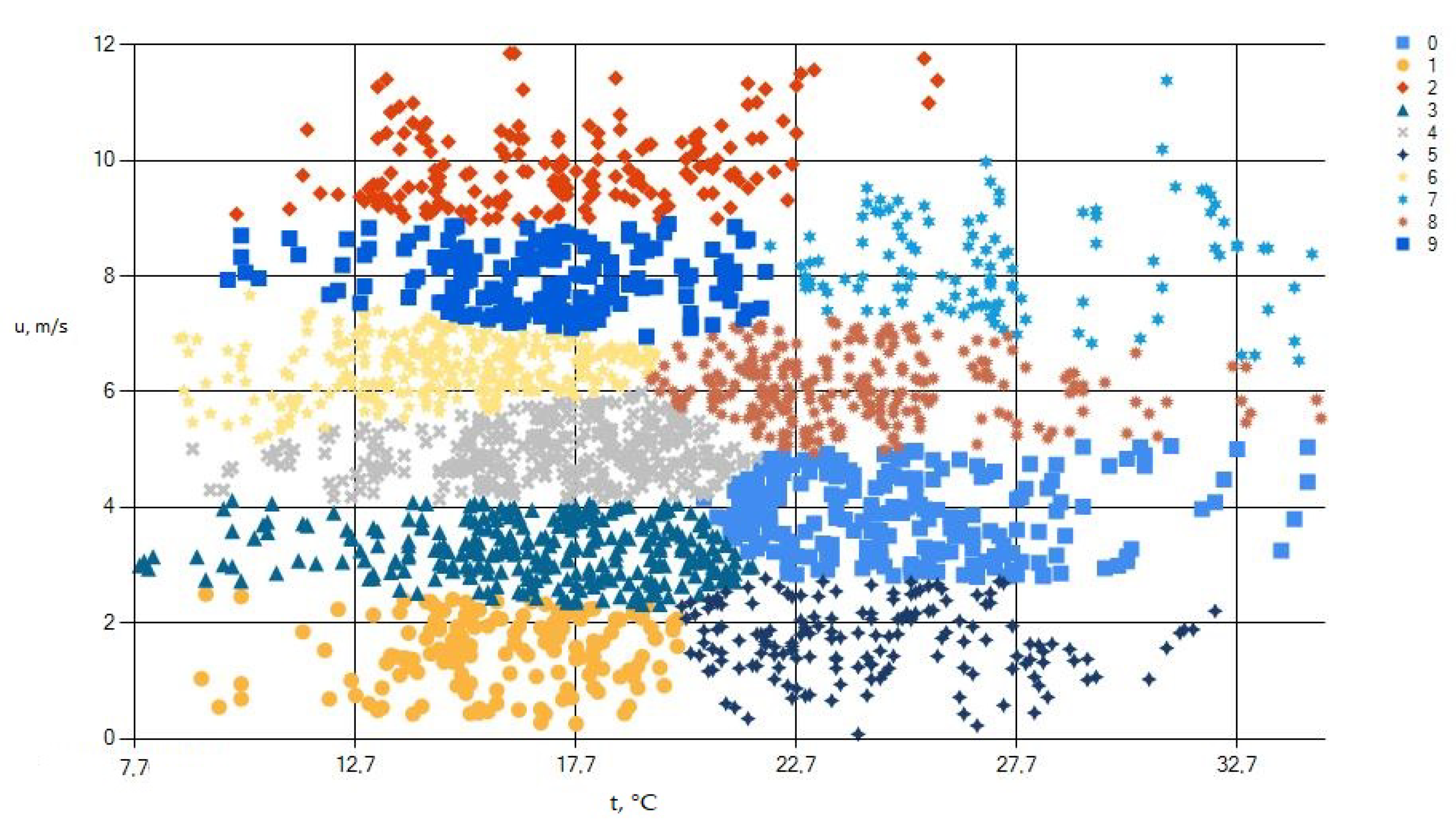

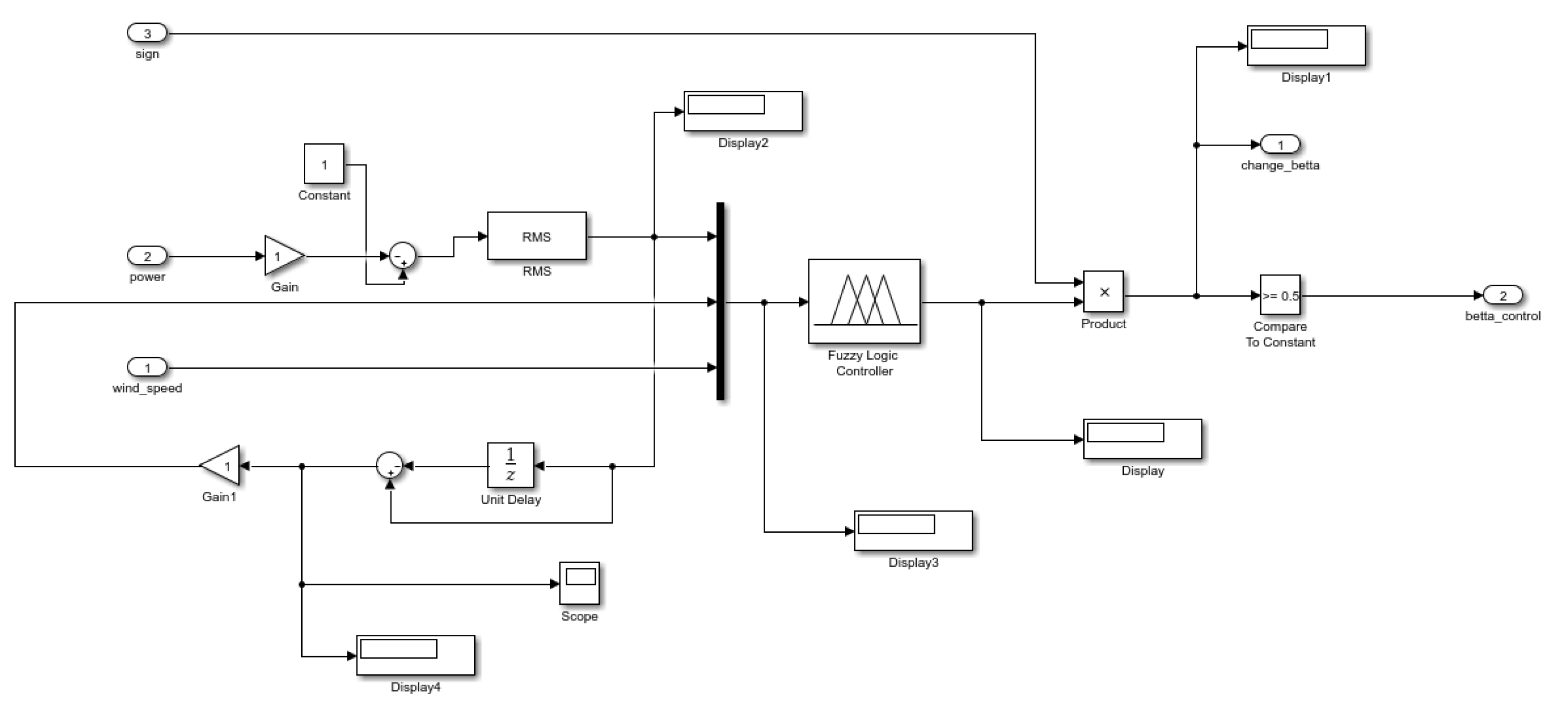

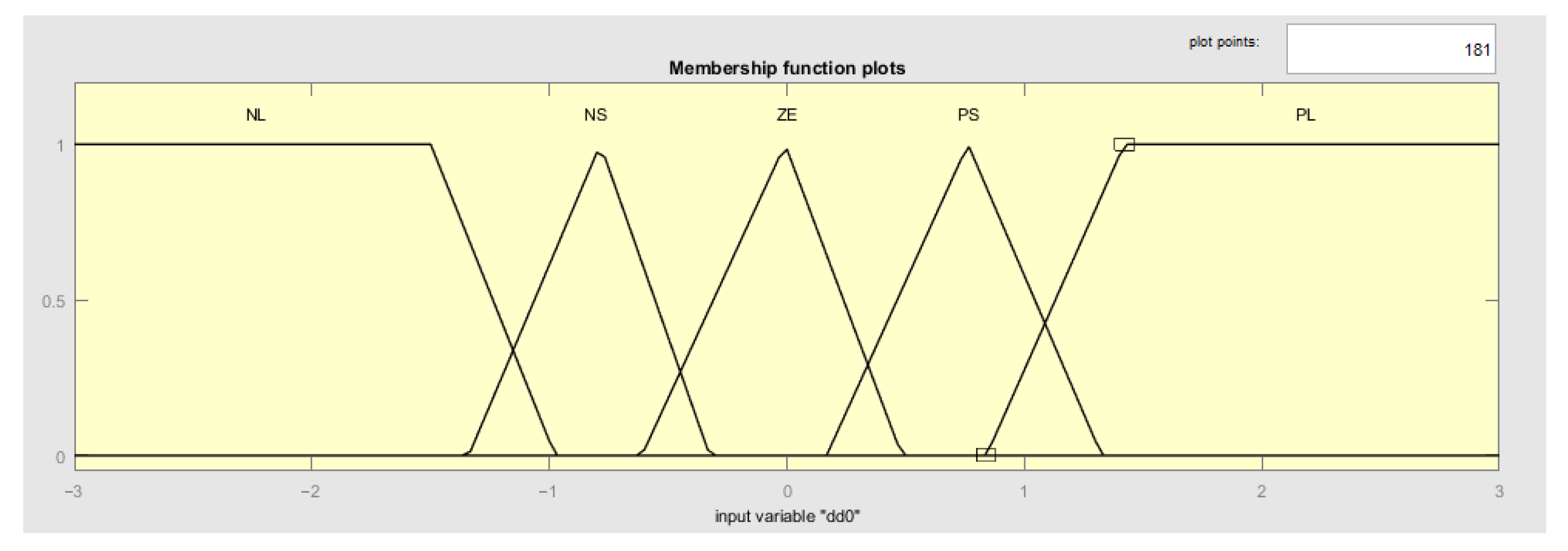
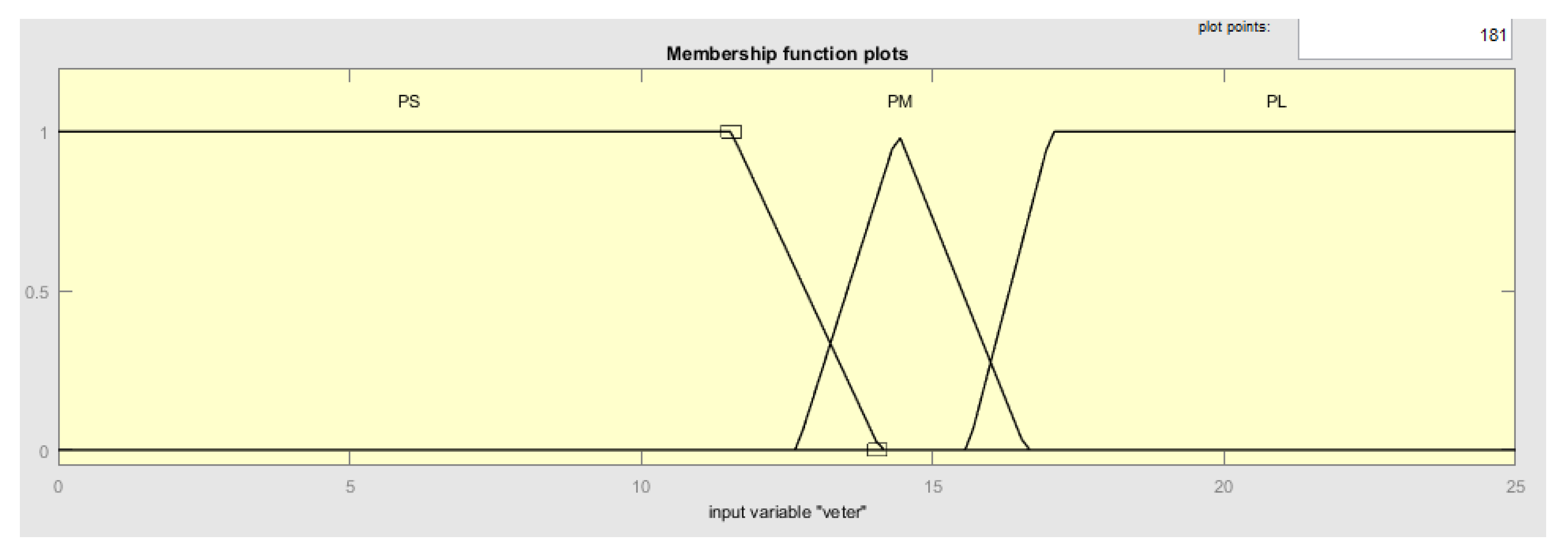




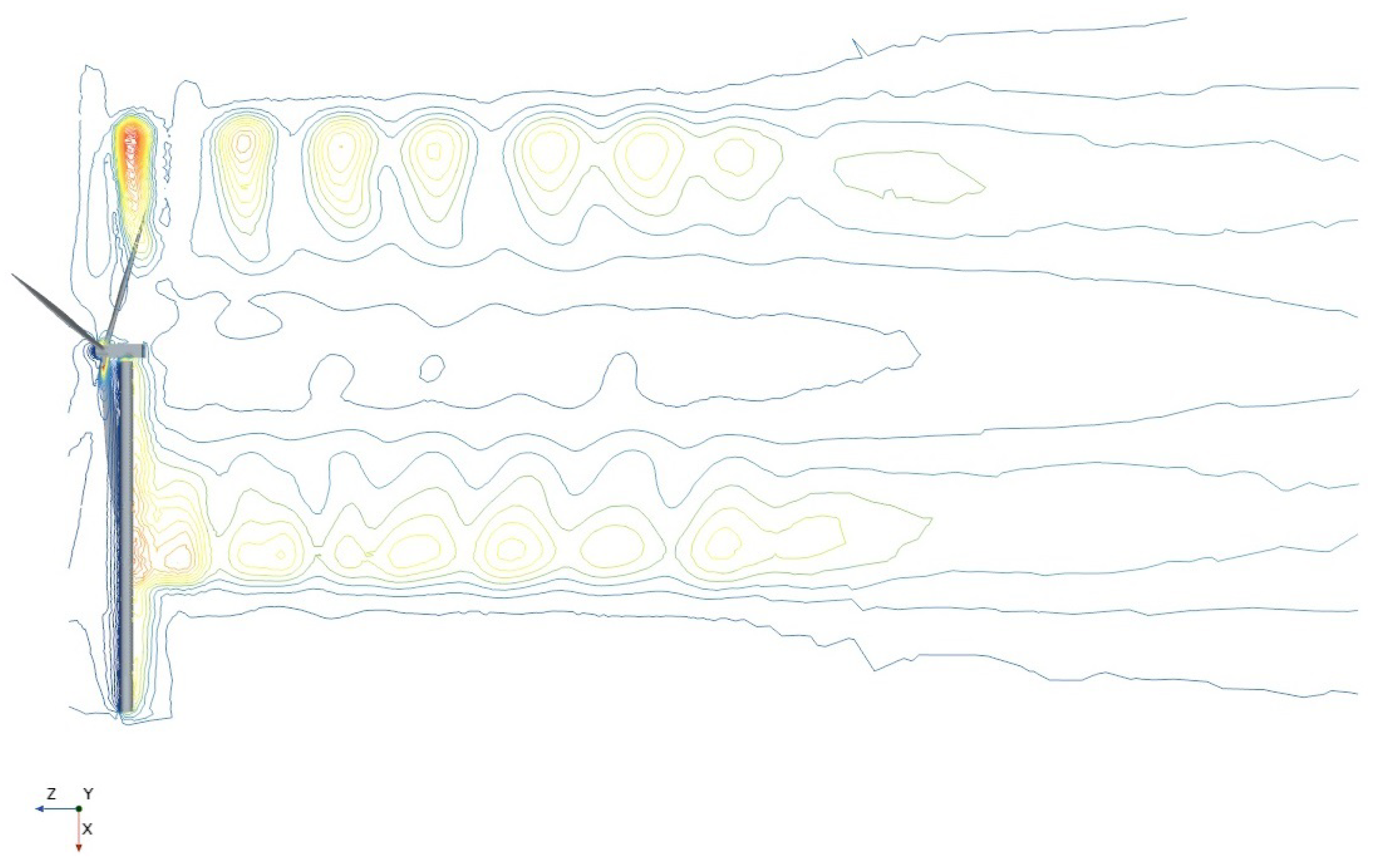
| PS | PM | PL | |||||||||||||
|---|---|---|---|---|---|---|---|---|---|---|---|---|---|---|---|
| NL | NS | ZE | PS | PL | NL | NS | ZE | PS | PL | NL | NS | ZE | PS | PL | |
| NL | NL | NML | NM | NM | PS | NL | NM | NM | NS | PS | NML | NM | NS | NS | PS |
| NS | NL | NM | NS | PS | PM | NML | NM | NS | PS | PM | NML | NM | NS | ZE | PS |
| ZE | NML | NS | ZE | PS | PML | NM | NS | ZE | PS | PM | NM | NS | ZE | PS | PM |
| PS | NM | NS | PS | PM | PL | NM | NS | PS | PM | PML | NS | ZE | PS | PM | PML |
| PL | NS | PM | PM | PML | PL | NS | PS | PM | PM | PL | NS | PS | PS | PM | PML |
| Type | k-Epsilon | k-Omega | ||||
| Mesh | №1 | №2 | №3 | №1 | №2 | №3 |
| Number of cells | 3,436,784 | 5,479,298 | 20,988,172 | 3,436,784 | 5,479,298 | 20,988,172 |
| Velocity deficit normalized with the free stream velocity (4D) | 0.35 | 0.39 | 0.42 | 0.36 | 0.39 | 0.41 |
| Experimental value | 0.43 | 0.43 | 0.43 | 0.43 | 0.43 | 0.43 |
| Difference in values (%) | 18.6 | 8.256 | 1.163 | 16.28 | 8.6 | 4.23 |
| Type | Reynolds Stress | Spalart Allmaras | ||||
| Mesh | №1 | №2 | №3 | №1 | №2 | №3 |
| Number of cells | 3,436,784 | 5,479,298 | 20,988,172 | 3,436,784 | 5,479,298 | 20,988,172 |
| Velocity deficit normalized with the free stream velocity (4D) | 0.33 | 0.38 | 0.41 | 0.31 | 0.37 | 0.40 |
| Experimental value | 0.43 | 0.43 | 0.43 | 0.43 | 0.43 | 0.43 |
| Difference in values (%) | 23.25 | 12.65 | 5.58 | 27.91 | 14.36 | 7.31 |
Disclaimer/Publisher’s Note: The statements, opinions and data contained in all publications are solely those of the individual author(s) and contributor(s) and not of MDPI and/or the editor(s). MDPI and/or the editor(s) disclaim responsibility for any injury to people or property resulting from any ideas, methods, instructions or products referred to in the content. |
© 2023 by the authors. Licensee MDPI, Basel, Switzerland. This article is an open access article distributed under the terms and conditions of the Creative Commons Attribution (CC BY) license (https://creativecommons.org/licenses/by/4.0/).
Share and Cite
Kovalnogov, V.N.; Fedorov, R.V.; Chukalin, A.V.; Kornilova, M.I.; Karpukhina, T.V.; Petrov, A.V. Application of Intelligent and Digital Technologies to the Tasks of Wind Energy. Energies 2023, 16, 481. https://doi.org/10.3390/en16010481
Kovalnogov VN, Fedorov RV, Chukalin AV, Kornilova MI, Karpukhina TV, Petrov AV. Application of Intelligent and Digital Technologies to the Tasks of Wind Energy. Energies. 2023; 16(1):481. https://doi.org/10.3390/en16010481
Chicago/Turabian StyleKovalnogov, Vladislav N., Ruslan V. Fedorov, Andrei V. Chukalin, Mariya I. Kornilova, Tamara V. Karpukhina, and Anton V. Petrov. 2023. "Application of Intelligent and Digital Technologies to the Tasks of Wind Energy" Energies 16, no. 1: 481. https://doi.org/10.3390/en16010481





